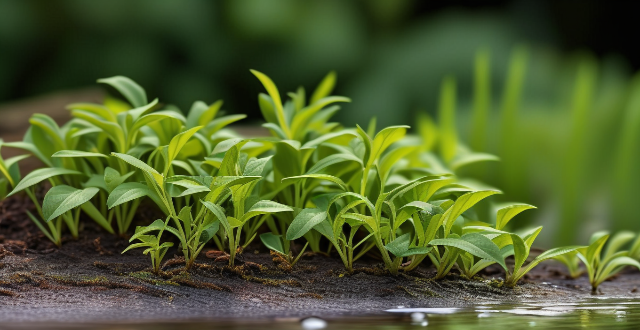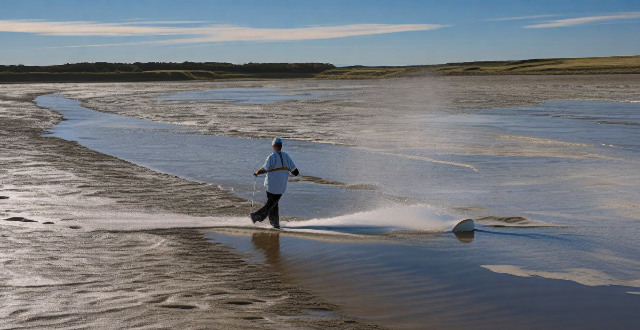Water Soil

What measures can be taken to reduce agricultural water consumption ?
Agriculture is the largest consumer of water worldwide, accounting for approximately 70% of global freshwater withdrawals. Reducing agricultural water consumption is crucial for sustainable water management and food security. Here are some measures that can be taken to achieve this goal: 1. **Improved Irrigation Systems** - Drip irrigation delivers water directly to the root zone of plants, reducing waste through evaporation and runoff. - Sprinkler irrigation uses pipes or hoses to spray water over crops, allowing more precise control than surface methods. - Micro-irrigation includes drip tapes and micro-sprayers, which apply water slowly and directly to plant roots. 2. **Water-Saving Technologies** - Soil moisture sensors help farmers determine when and how much to irrigate based on soil moisture levels. - Weather stations provide data on rainfall, temperature, and humidity, enabling farmers to adjust irrigation schedules accordingly. - Automated control systems allow for real-time adjustments in irrigation based on sensor information. 3. **Efficient Crop Management** - Crop rotation helps maintain soil health and reduces water demand by alternating between high and low water-consuming crops. - Planting cover crops protects soil from erosion and improves its ability to retain moisture. - Intercropping leads to efficient use of resources, including water. 4. **Soil Health Management** - Composting adds organic matter, improving soil structure and making it better at holding water. - Minimal tillage helps maintain soil structure, reducing water loss through evaporation. - Mulching covers soil with layers of organic material, conserving moisture by reducing evaporation. 5. **Water Pricing and Policies** - Volumetric pricing encourages conservation among farmers by charging for water based on actual usage. - Subsidies for water-saving technologies promote adoption of water-efficient practices. - Regulations limiting excessive water extraction can drive efficiency improvements. 6. **Rainwater Harvesting** - Catchment systems collect rainwater from roofs or other surfaces for later use in irrigation. - Berms and swales divert runoff into fields or storage areas for future irrigation needs. 7. **Education and Training** - Extension programs provide farmers with knowledge about water-saving techniques through workshops and demonstrations. - Farmer field schools offer hands-on training sessions where farmers learn best practices directly in their fields. 8. **Genetic Improvement of Crops** - Drought-resistant varieties develop crop varieties that require less water without sacrificing yield. - Breeding programs enhance crops through selective breeding to increase their water use efficiency. 9. **Integrated Pest Management (IPM)** - Biological control methods reduce the need for water-intensive pesticide applications using natural predators. - Cultural practices like crop rotation and intercropping also help control pests naturally. 10. **Land Leveling** - Terrace construction on sloping lands helps retain water and prevent runoff. - Land leveling equipment ensures even water distribution during irrigation. By implementing these measures, agriculture can become more water-efficient, ensuring there is enough water available for both current and future generations while maintaining agricultural productivity.

What kind of soil is best for indoor plants ?
The ideal soil for indoor plants should be well-draining, lightweight, and rich in nutrients. It should contain ingredients like perlite or sand to improve drainage, be lightweight to allow better aeration and root growth, and provide essential nutrients such as nitrogen, phosphorus, and potassium. Popular soil mixes for indoor plants include potting soil mix, coco coir mix, orchid bark mix, and cactus and succulent mix. Each of these mixes caters to different types of plants and their specific needs.

How often should I water my indoor plants ?
Indoor plants require proper watering to thrive. The frequency of watering depends on soil moisture, plant type, and environmental conditions. Most houseplants benefit from being watered every 7-14 days, while succulents and cacti can go longer between waterings. It's important to check the soil before watering and adjust your routine based on the plant's health and growth patterns. With proper care, your indoor plants will thrive and bring life to your space.

How does deforestation contribute to water cycle disruption ?
Deforestation contributes to water cycle disruption through soil erosion, surface runoff, and groundwater depletion. This leads to droughts, flooding, pollution, water scarcity, and climate change. Sustainable forest management is crucial to mitigate these effects.

How does climate variability impact agriculture and food security ?
Climate variability significantly impacts agriculture and food security by affecting crop yields, livestock production, and the availability and accessibility of food. Direct impacts include changes in temperature, precipitation, extreme weather events, and CO₂ levels, while indirect impacts involve pest and disease outbreaks, water resource availability, soil quality, ecosystem services, market prices and trade, food accessibility and nutrition, and farmer livelihoods. Mitigation and adaptation strategies such as crop diversification, improved water management, breeding resilient crops, sustainable soil management, early warning systems, insurance and safety nets, policy support, and international cooperation are essential for building a climate-resilient food system.

How does rainwater harvesting contribute to environmental sustainability ?
Rainwater harvesting contributes to environmental sustainability by reducing water consumption, enhancing soil health and erosion control, mitigating flood risks, reducing pollution, and promoting biodiversity. By collecting and using rainwater for various purposes such as irrigation, cleaning, and even drinking, we can significantly reduce our reliance on municipal water supplies. This helps conserve freshwater resources and reduces the energy required to treat and transport water from sources to our homes and businesses. Rainwater harvesting also enhances soil health by allowing rainwater to soak into the ground instead of running off into storm drains, which helps replenish groundwater reserves and improves soil moisture levels. Additionally, capturing and storing rainwater on site can reduce the amount of water that enters storm drains during heavy rainfall events, alleviating pressure on urban drainage systems and reducing the risk of flooding in low-lying areas or areas with poor drainage. Furthermore, rainwater harvesting reduces pollution by preventing pollutants such as fertilizers, pesticides, and other chemicals from entering local waterways when rainwater is collected and used instead of being allowed to flow into storm drains. Finally, rainwater harvesting promotes biodiversity by creating habitats for native plants and animals through the creation of rain gardens, bioswales, and other green infrastructure projects.

How do different regions of the world experience the impacts of climate change on agriculture differently ?
Climate change affects agriculture differently across the globe, depending on local climate conditions, soil types, water availability, and agricultural practices. In tropical regions, high temperatures and humidity, along with frequent extreme weather events and pest and disease pressure, negatively impact crop yields. Arid and semi-arid regions face water scarcity due to reduced rainfall and increased evaporation rates, leading to limited agricultural productivity. Desertification causes soil degradation and loss of arable land. Temperate regions experience changes in precipitation patterns, affecting crop growth, while warmer winters can extend growing seasons. Extreme weather events can damage crops and reduce yields. Polar regions see extended growing seasons due to warming temperatures, but permafrost melting causes soil instability, and changes in ocean currents affect fishing industries. Mountainous regions face changes in temperature and precipitation that alter snowmelt timing and amount, affecting water availability for irrigation. Glacier retreat reduces water supplies for downstream communities and agriculture, while natural disasters like landslides destroy crops and damage infrastructure.

How does ecological design address issues related to water management and consumption ?
Ecological design addresses water management and consumption issues through strategies such as rainwater harvesting, water recycling, using native plants in landscaping, installing efficient water fixtures, permeable paving, smart water management systems, and promoting education on water conservation.

What are the best practices for managing water resources in agriculture ?
Proper management of water resources is crucial for sustainable agriculture, and there are several best practices that can help farmers conserve and use water efficiently. These include soil moisture monitoring, drip irrigation, mulching, rainwater harvesting, crop rotation and intercropping, efficient irrigation scheduling, integrated pest management, water-saving plants, and maintenance of irrigation systems. By following these practices, farmers can effectively manage their water resources while maintaining productivity and profitability in their agricultural operations.

What are some tips for reducing water consumption at home ?
Reducing water consumption at home can be achieved through various methods, including fixing leaks, installing water-saving fixtures, using efficient appliances, changing habits, being smart with gardening, and monitoring usage. By checking for drips, tightening fixtures, upgrading to low-flow toilets and showerheads, using Energy Star washers and dishwashers, turning off the tap while brushing teeth or shaving, watering the garden in the morning, and regularly reading the water meter, households can save money on utility bills and contribute to a more sustainable environment.

How can climate services be used to manage water resources effectively ?
Climate services play a critical role in water resources management by providing accurate and timely information on weather patterns, climate change, and related phenomena. These services can be used to forecast precipitation, monitor river levels for flood early warning systems, assess the impact of climate change on water availability, plan adaptation measures, monitor drought conditions, manage water quality, and protect ecosystems. By leveraging these services, we can ensure the effective use of water resources, adapt to changing climates, prepare for extreme weather events, and guarantee a sustainable water supply for future generations.

How does climate change affect the quality and availability of drinking water ?
This article discusses the various ways in which climate change affects the quality and availability of drinking water, including changes in precipitation patterns, melting glaciers, sea level rise, temperature increase, extreme weather events, and wildfires. It also explores adaptation strategies such as water conservation measures, infrastructure improvements, protection of water sources, and policy and regulation to mitigate these risks and ensure a sustainable water future for all.

What role do wetlands play in water purification and flood control ?
In summary, wetlands are crucial ecosystems that play a vital role in water purification and flood control. They act as natural filters, removing sediments, nutrients, and pollutants from water while also providing buffering capacity for floodwaters. By preserving and restoring wetlands, we can ensure clean water resources and minimize the risks associated with flooding.

What is the significance of green infrastructure in managing urban runoff and improving water quality ?
Green infrastructure (GI) is a sustainable approach that uses natural processes to manage stormwater, reduce pollution, and enhance the overall health of urban ecosystems. It plays a crucial role in managing urban runoff and improving water quality. Some benefits of GI include reducing stormwater runoff, improving water quality, enhancing habitat and biodiversity, and mitigating climate change impacts. To effectively implement green infrastructure in urban areas, factors such as site selection, design considerations, and maintenance and management should be considered. Proper maintenance and management are essential for ensuring the long-term success of green infrastructure projects. By implementing effective green infrastructure practices, cities can create healthier, more resilient environments for both people and wildlife.

What is carbon sequestration and how does it work ?
Carbon sequestration is a process that aims to reduce the concentration of carbon dioxide (CO2) in the atmosphere by capturing and storing it. This can be achieved through various methods, including afforestation, soil carbon sequestration, bioenergy with carbon capture and storage (BECCS), direct air capture (DAC), ocean carbon sequestration, and enhanced weathering. The benefits of carbon sequestration include mitigating climate change, improving soil health, restoring ecosystems, and creating economic opportunities. However, large-scale implementation of carbon sequestration projects faces challenges, and continued research and investment are necessary to achieve global climate goals.

What are some of the most effective methods for carbon sequestration ?
Carbon sequestration refers to the process of capturing and storing carbon dioxide (CO2) from the atmosphere to mitigate its effects on climate change. There are several effective methods for carbon sequestration, including afforestation and reforestation, soil carbon sequestration, biochar production, ocean fertilization, and direct air capture (DAC). Afforestation and reforestation involve planting new trees or replacing existing ones in deforested areas, while soil carbon sequestration involves increasing the amount of organic matter in soil by adding compost, manure, or other organic materials. Biochar production involves creating a type of charcoal made from plant materials that is added to soil to improve its fertility and water-holding capacity. Ocean fertilization involves adding iron or other nutrients to the ocean to stimulate the growth of phytoplankton, which absorb CO2 through photosynthesis. Direct air capture involves using machines to capture CO2 directly from the atmosphere and then store it underground or in other long-term storage solutions.

How does electronic waste affect the environment if not recycled ?
Electronic waste, or e-waste, refers to discarded electronic devices such as computers, smartphones, and televisions. Improper disposal of these items can have severe consequences for the environment, including the release of toxic chemicals into soil, water, and air. These chemicals can cause health problems for both humans and wildlife. Non-recycled e-waste also occupies valuable landfill space and contributes to soil contamination, water pollution, and air pollution. Proper recycling of electronic waste is essential to protect the environment and human health, conserve natural resources, and minimize the impact on landfills.

How do I propagate my indoor plants ?
Propagating indoor plants is a rewarding activity that allows you to expand your collection without spending much money. Here's a step-by-step guide on how to propagate your indoor plants: 1. Choose the right plant: Some common houseplants that are easy to propagate include pothos, succulents, snake plants, and spider plants. Make sure to choose a plant that is healthy and free from pests or diseases. 2. Gather your tools: You will need some basic tools for propagation, including sharp scissors or pruners, clean pots with drainage holes, potting soil, and possibly rooting hormone (depending on the plant). 3. Choose a method of propagation: There are several methods of propagation, including stem cuttings, leaf cuttings, division, and layering. The method you choose will depend on the type of plant you have. 4. Prepare your cuttings: Using sharp scissors or pruners, make clean cuts just below a node (the point where leaves attach to the stem) on your chosen plant. Remove any lower leaves that would be below the soil line as these can rot and cause problems later on. 5. Plant your cuttings: Fill your pots with fresh potting soil making sure there are drainage holes at the bottom. Make a small hole in the soil and insert your cutting about halfway down. Water gently to settle the soil around the cutting. 6. Provide proper care: Place your newly planted cuttings in a warm bright location but out of direct sunlight Keep the soil moist but not waterlogged Avoid letting it dry out completely You may also want to cover your pot with a plastic bag or dome to create a humid environment which helps promote root growth. 7. Be patient and observe growth It can take several weeks to months for your cuttings to develop roots and new growth Once you see new leaves forming you know that your plant has successfully rooted and is ready to continue growing independently. 8. Transplant if needed Once your plant has outgrown its current pot or seems rootbound it's time to transplant it into a larger container with fresh potting soil Be gentle when handling the delicate new roots during transplantation.

How effective are large-scale water transfer projects in alleviating water scarcity ?
Water scarcity is a global issue, and large-scale water transfer projects aim to alleviate it by transporting water from areas with abundant resources to those with scarce ones. These projects can increase water availability, diversify water sources, and provide environmental benefits such as restoring depleted aquifers and wetlands. However, they also face challenges like high costs, negative environmental impacts, and social and political issues. To maximize the benefits of these projects while minimizing their drawbacks, careful consideration of their potential consequences and involvement of all relevant stakeholders in the decision-making process are essential.

How can we improve water resource management in our community ?
The article discusses the importance of water resource management in our community and suggests various strategies to improve it. These include raising awareness through educational campaigns, implementing water-saving measures like fixing leaks and using low-flow fixtures, upgrading infrastructure such as wastewater treatment plants, promoting sustainable practices like xeriscaping and green roofs, and fostering collaborative efforts among different stakeholders. By adopting these approaches, we can ensure the long-term availability of clean water while protecting the environment.